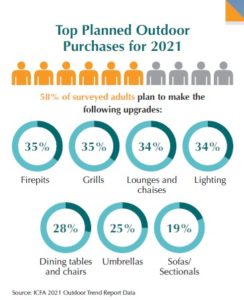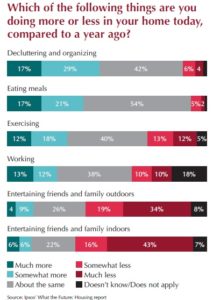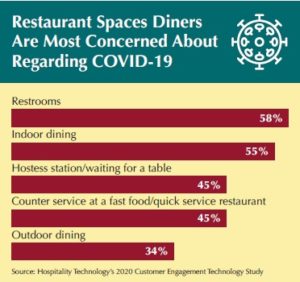Consumers have made dramatic shifts due to the coronavirus pandemic and so have the facilities they occupy. Social distancing, or more aptly, physical distancing, has forced businesses and residences to rethink their layouts and purposes to accommodate new preferences and best practices. While the vaccine and safety protocols have helped return some sense of normal, some changes to stop the virus’ spread have spurred new facility concepts that will remain throughout the pandemic and beyond.
OUTDOOR EMPHASIS
The outdoors has been a respite for millions as a safe place to connect with others and enjoy activities. According to a recent Ipsos survey, 13% of Americans are entertaining family and friends more outdoors than a year ago, and 24% of respondents with children are doing the same. In response, homeowners and designers are prioritizing the outdoors and backyards with innovative improvements to increase engagement and fun.
Outdoor Design and Backyarding
A recent survey of designers by Unity Marketing in conjunction with The American Marketing Group highlighted the opportunities in extending living spaces to the outdoors. Nearly 90% of respondents say that they have been designing outdoor living spaces over the previous two years and 80% say outdoor spaces were their top growth category. “Outdoors is no longer a separate space, but a continuation of what’s happening on the interior. With COVID-19, nature has become an essential resource to stay healthy and happy and that means outdoor will be increasingly important. The line between what looks indoor vs. outdoor is becoming ever more blurred,” says a designer. One consequence of COVID-19 is the rise of “backyarding,” referring to using the backyard space for more activities. According to a new study by the International Casual Furnishings Association (ICFA), 88% of Americans are dissatisfied with their outdoor spaces, citing its style (66%), function (56%) and comfort (45%) as lacking. Interestingly, 90% believe their outdoor living area is more valuable than ever. Many Americans (78%) seized the opportunity to upgrade their backyards in 2020. The top upgrades were planted trees (38%), new garden space (29%), new furniture (23%), a deck (18%) and fencing (18%). Millennials outpace baby boomers in outdoor purchases by 53% to 29%. Among other modifications they are making the front yard a more social area for residents to gather and interact with neighbors and play structures for kids that seamlessly blend into the landscape. In the Buffalo, N.Y., region, landscaping companies were overwhelmed with orders for backyard ice rinks during the winter.

THE HOME TAKES ON ADDED MEANING
Home Kitchen Upgrades
As the pandemic forced people to stay inside more and limited restaurant options, consumers have been more willing to pay premiums for luxury kitchen amenities, reports Zillow. Six of the top 10 features mentioned in house listings that sold for more than expected in 2020 were kitchen related. Among the features associated with the highest price increases were steam ovens (4.9% premium), pizza ovens (3.4%), new appliances (3.2%), quartz countertops (3.2%), smart appliances (3.0%) and butcher blocks (2.7%).

School and Work
Homes are adapting to remote work and schooling. According to the Ipsos survey, 60% of respondents with children at home report their kids are taking part in e-learning. Thirtyseven percent of respondents also said that they are working remotely and over half (52%) of households with incomes over $100,000 say they are working from home.
Home Fitness
As many as 59% of Americans will not renew their gym memberships after the pandemic, reports TD Ameritrade. As a result, the American College of Sports Medicine ranked online training as its top trend for 2021. Home fitness has spiked as brands like Peloton saw profits grow by 100% last year. Also, on-demand programs like KKSweat, which launched last March, produce 15 weekly classes for more than 500 people. While the social dynamic of home workouts is different, it has shifted to the digital world via chat rooms built into workout apps, comparing workout results and attendance recording. Other programs utilize wearables like FightCamp, which uses Bluetooth “punch trackers” in hand wraps to track the effectiveness of punches. After the pandemic, experts agree that the in-home workout segment will remain.
INCENTIVES TO MOVE
Cities are offering cash incentives up to $16,000 to individuals via home allowances, tax credits and money toward local goods and services to draw people to live there. One service, MakeMyMove, functions as a directory for these incentives. Savannah, Ga., offers $2,000 for moving expenses to certain tech professionals to work remotely. Other cities that participate include Montpelier, Vt., ($15,000) Tulsa, Okla., ($11,000) and Baltimore ($5,000). According to Cofounder Evan Hock, users tend to live in expensive coastal locations like California and New York, and work in technology, marketing and sales. Motivations to move include being closer to family, lower cost of living and being closer to the outdoors.
WORKPLACE CHANGES
The pandemic upended the workplace, particularly whitecollar jobs that transitioned into fully remote formats, but as COVID-19 cases decrease, businesses are strategizing how to utilize their office spaces with the prospect of bringing back at least some employees.
Where Businesses Are Now
According to a recent Price Waterhouse Coopers report, 55% of employees want to work remotely at least three days a week. Conversely, 68% of executives believe employees should be in the office at least three days a week to preserve a strong company culture. The recent Cushman & Wakefield Total Workplace report generated data from focus groups and interviews with business owners, occupiers and placemakers (i.e., business improvement district directors) to discuss remote work, office layouts, and challenges and opportunities for businesses. Here are its findings. Remote work succeeds. The focus group noted that shifting to remote work has exceeded expectations. Work from home (WFH) fatigue may hamper productivity. Participants raised concerns over WFH fatigue and employees’ eagerness to connect in-person again. Virtual meetings have allowed workers to meeting remotely, but the number of meetings have increased for some and created fatigue.
Corporate culture impacts. Some business leaders worry that a lack of face-to-face communication will erode corporate culture. Without strong cultural capital, HR will be relied upon to create more positive employee experiences.
Innovation in-person. The group agreed that in-person communication created a more innovative work environment. Businesses have an opportunity to create more vibrant and active workplaces that are often walkable for employees.
More time is needed. Many respondents were unsure of their long-term plans. Leasing data for 2020 reveals that short-term renewals have increased above normal rates as leaders remain uncommitted to longer-term goals and collect data to address their needs. The group offered several changes they expect to see:
- 100% remote work will be rare.
- Layouts will eventually change to include more communal spaces and meeting areas, like cafes and comfortable seating spaces.
- In-person FOMO (fear of missing out). While there are benefits from WFH, some respondents indicated that remote workers may fear missing out in the influence in-office workers will have.
Where Businesses Are Heading
While businesses decide how to bring people back to the workplace, several additional trends are developing. A fall Upwork survey of hiring managers indicates that the number of teams and departments working entirely remote in the next five years will grow from 12% to 23%, and the number working partially remote will increase from 9% to 15%. As businesses reimagine their work format, Salesforce President and Chief People Officer Brent Hyder offers several ways to plan ahead.
Engage Employees Like Customers. HBR research shows that businesses want better employee experiences, but few workers feel their employers prioritize them. Companies should have the tools to create consumer-like experiences to engage employees throughout their tenure.
Be Flexible. The pandemic has prioritized workplace flexibility. Some ideas include designated days off, no-meeting days and meal reimbursements.
Empathetic Leadership. Employers should rethink how they develop talent by prioritizing soft skills that can strengthen company culture.
Expand the Talent Pool. As work goes remote, employers can tap into talent pools beyond their locality.
OTHER FOCUS AREAS FOR CHANGE
Dining
 As restaurants have adjusted to survive during COVID-19, some are looking ahead to include models that will allow them to thrive post pandemic, reports restaurant publication FSR. Streamlined Restaurant Models Bonchon, a Korean fried chicken chain, moved to a limited service model during the pandemic. Since, it has become successful enough to make the model permanent. The goal of downsizing was to lower costs while maintaining quality. The restaurant also emphasized its online presence via web and mobile ordering. Prior to the pandemic, about 55% of business was dine-in and 11% third-party delivery. By the end of 2020, dine-in was only around 11% of sales, delivery 35% and curbside service at 40%. Kenny Gilbert, former personal chef to Oprah, launched a streamlined food operation after COVID-19 halted his plan to open a restaurant. After selling meals prepared in his kitchen at home, Gilbert eventually bought a restaurant space, but now only has himself and another cook to perform tasks like cooking and cleaning and has a cashier for customer orders. Operating at a dramatically lower cost was worth it for the chef. “I think about how much money I spent just on paper in the past, changing out menus, all that kind of stuff,” comments Gilbert.
As restaurants have adjusted to survive during COVID-19, some are looking ahead to include models that will allow them to thrive post pandemic, reports restaurant publication FSR. Streamlined Restaurant Models Bonchon, a Korean fried chicken chain, moved to a limited service model during the pandemic. Since, it has become successful enough to make the model permanent. The goal of downsizing was to lower costs while maintaining quality. The restaurant also emphasized its online presence via web and mobile ordering. Prior to the pandemic, about 55% of business was dine-in and 11% third-party delivery. By the end of 2020, dine-in was only around 11% of sales, delivery 35% and curbside service at 40%. Kenny Gilbert, former personal chef to Oprah, launched a streamlined food operation after COVID-19 halted his plan to open a restaurant. After selling meals prepared in his kitchen at home, Gilbert eventually bought a restaurant space, but now only has himself and another cook to perform tasks like cooking and cleaning and has a cashier for customer orders. Operating at a dramatically lower cost was worth it for the chef. “I think about how much money I spent just on paper in the past, changing out menus, all that kind of stuff,” comments Gilbert.
Additionally, “ghost kitchens” or delivery-only models have risen in popularity in the wake of the pandemic, providing much needed revenue for restaurants without the overhead of traditional models. Some experts believe that ghost kitchens will remain as the pandemic ends and new dining habits take form. Delivery-first consumers are likely to stay, says Shiv Sundar, co-founder and CEO of Esper, an android technology company. The rise of delivery apps like UberEats and DoorDash are likely to keep ghost kitchens relevant, particularly for delivery-first eaters.
New Dine-in Models
While many restaurants have pivoted away from brick-and mortar facilities, some restaurant operators have made plans to boost dine-in service and capitalize on pent up demand for a traditional sit-down restaurant experience. According to Technomic, 68% of consumers say they are very excited to dine at restaurants. Houston’s Dish Society is a hybrid model that offers over-the-counter service during the day and full-service at night. Charles Bililies, founder of Souvla, a “fine fast” San Francisco Greek restaurant chain, envisions a model with outdoor and open air-seating for his facilities.
Appealing Restaurant Features
COVID-19 protocols dominate what influences customer decisions when selecting specific restaurants, reports Hospitality Technology’s 2020 Customer Engagement Technology Study. Clear, transparent communications regarding COVID-19 protocols ranks as the top factor influencing restaurant selection for 73% respondents. Next is reduced dining capacity at 71%, followed by hand sanitizer availability at 70%. Other features that customers prioritize when selecting restaurants include that the restaurant has positive consumer reviews and ratings, menus and nutritional information can be previewed, easy online reservations, Wi-Fi and mobile ordering/payment.
Hotel Trends
Facilities are using technology such as UV light and electro spray devices to keep surfaces clean. Hotels are capitalizing on the remote fitness trend by expanding the utility of their rooms by offering fitness experiences, like on-demand virtual workouts, stationary bikes and treadmills and other enhancements. Booking.com research indicates that 70% of global travelers say they would be more likely to book a stay knowing it was eco-friendly, whether they were looking for a sustainable stay or not. EPA data indicates that indoor air quality may be two to five times more polluted than outdoor air. And as awareness of airborne pathogens has grown, so has the need to improve air purification systems, reports Hotel Business. Consumers will expect new air filter technologies that capture and destroy particles to be installed by offices, hotels, restaurants, fitness centers and other indoor spaces.
New Wellness Facilities and Services
As society continues its shift to improve individuals’ wellbeings, more steps are being taken to provide homes, workplaces and hospitality venues with resources to help people relax and make spaces restorative, reports Global Wellness Institute’s study, “Defining the Mental Wellness Economy.” More cities worldwide are offering pay-to-nap spaces to let people take a quick nap to catch up on rest. These “nap pods” are also being installed in airports, workplaces and spas. Domestically, more than 50% of respondents to a Mindbody survey report being interested in a nap facility. Similarly, meditation studios have become more popular with both virtual and in-person offerings. These classes are often held in yoga studios, gyms and fitness centers. Some services, like PauseNow in California and BETtime in New York City offer mobile studios and pods for users to unwind and listen to relaxing sounds or receive guided meditation. Some wellness apps that aim to reduce users’ stress like Headspace and Calm have expanded from the virtual world to the physical by offering in-person services at spas and sleep retailers and are considering plans for their own hotels and resorts.
STRUCTURAL CHANGES
COVID-19 has changed the world beyond individuals’ behavior and through the infrastructure in which they live. Physical spaces have changed through new layouts and functions to adapt to new preferences. As the prospect of the pandemic’s end becomes more tangible, clubs should consider facility and amenity changes that respond to their members evolving desires.
Club Trends Spring 2021


